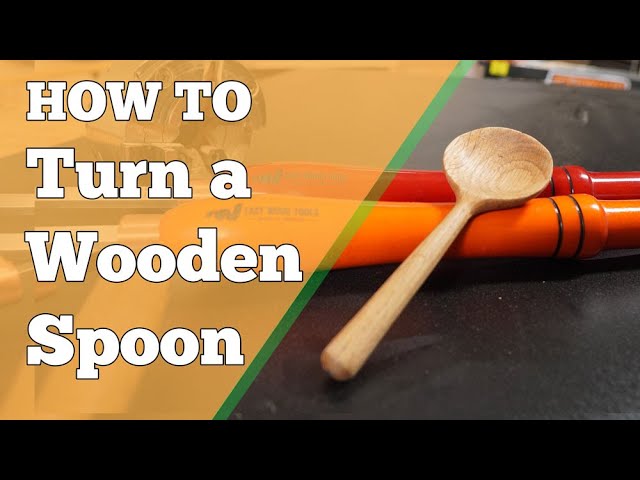Wooden Spoons: A Practical and Rewarding Beginner Project
If you’re looking for a simple yet satisfying beginner woodturning project, wooden spoons are an excellent choice. Turning spoons on the lathe offers the perfect opportunity to practice basic turning techniques while creating a functional, handcrafted item. Plus, wooden spoons make great gifts and are always in demand for anyone who appreciates handmade kitchenware.
In this blog post, we’ll explore why wooden spoons are an ideal starting point for new woodturners and provide some tips on how to successfully create your beautiful spoons.
Why Wooden Spoons Are Great for Beginners
1. Practice Simple Curves and Shaping
One of the main skills you’ll develop when turning wooden spoons is learning to shape smooth curves. Unlike more complex projects, spoon turning focuses on a few simple profiles: the handle, bowl, and neck. This gives you the chance to practice your gouges, chisels, and sandpaper skills, all while working on a smaller scale.
2. Small Wood Blanks for Ease of Handling
Wooden spoons are made from small wood blanks, which make them easier to handle and manipulate compared to larger projects. These small pieces allow you to practice cutting and shaping without being overwhelmed by the size or weight of the material. You can use a variety of hardwoods, such as cherry, maple, or walnut, which are durable and well-suited for kitchen tools.
3. Improving Cutting Skills
Shaping the spoon’s bowl and handle requires precision and control of your cutting tools. This project provides an excellent opportunity to fine-tune your tool control and cutting techniques. As you progress, you’ll become more confident in creating smooth, flowing curves and eliminating tool marks.
4. Creating Functional, Handmade Items
A major appeal of spoon-turning is the satisfaction of creating something functional. Wooden spoons are used in everyday life and can be highly prized for their craftsmanship. Whether you’re making spoons for yourself, as gifts, or to sell, your work will be appreciated for both its beauty and practicality.
How to Get Started with Wooden Spoon Turning
1. Choose Your Wood
Start with a hardwood like cherry, maple, or beech. These woods are dense, durable, and relatively easy to turn, making them ideal for spoon-making. You can find pre-cut spoon blanks or simply cut your own to the appropriate size for turning.
2. Mount the Wood Blank
Secure your wood blank to the lathe, making sure it’s centered properly. For spoon turning, you can use a faceplate or a chuck, depending on your lathe and the size of your wood blank. Ensure it’s tightly secured to avoid any wobbling or vibration while turning.
3. Rough Out the Shape
Using a roughing gouge, begin shaping the blank into a basic round or oval form. Focus on the overall proportions of the spoon, keeping the handle length and bowl shape in mind. Take your time to make smooth, even cuts as you shape the basic outline of the spoon.
4. Carve the Bowl
Once the basic shape is established, switch to a spoon gouge or bowl gouge to start hollowing out the bowl. This part of the process takes some skill and patience, as you’ll need to carve away material from the center while maintaining an even wall thickness. Start shallow and gradually deepen the bowl as you work.
5. Shape the Handle
Use your gouge or skew chisel to refine the handle’s shape. You can make it straight or slightly curved, depending on your design. Make sure the handle feels comfortable in the hand and is well-proportioned to the bowl.
6. Sanding and Finishing
Once the spoon is fully shaped, carefully sand the entire piece to remove tool marks and smooth the surface. Start with coarse grit and gradually work your way up to finer grits for a silky finish. You can apply a food-safe finish such as mineral oil or beeswax to protect the wood and enhance its natural color.
Tips for Successful Wooden Spoon Turning
- Use Sharp Tools: Sharp tools are essential for clean, smooth cuts. Dull tools can cause tear-out or rough surfaces, making your project more difficult.
- Work Slowly: Spoon turning can be delicate, especially when hollowing out the bowl. Take your time and work in stages to avoid mistakes.
- Practice Control: The key to a successful spoon is control over your gouge and how you remove wood. Focus on making light, controlled cuts rather than rushing.
- Experiment with Designs: You can experiment with different spoon designs, such as carving deep or shallow bowls, adding decorative elements to the handle, or trying different handle shapes.
Conclusion
Turning wooden spoons is a fantastic beginner project that teaches essential woodturning techniques. By focusing on shaping, cutting, and sanding, you’ll quickly improve your skills and build confidence with your lathe. Plus, the result is something both functional and beautiful—a handmade spoon that can be used every day or gifted to someone special.
So, grab your lathe tools, choose your wood, and start creating! Wooden spoons are not only a great way to get started with woodturning, but they also offer endless possibilities for personal creativity and craftsmanship.



